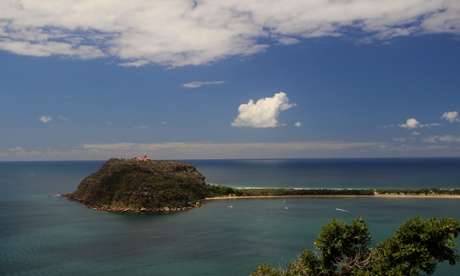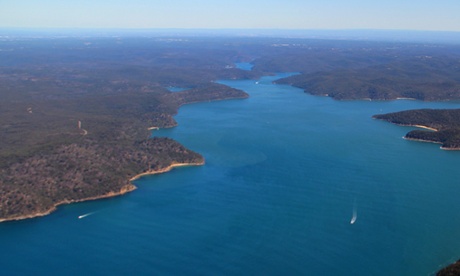
Brigid Delaney, The Guardian, July 24, 2015
A woman on my rock art tour who works in tourism reels off the usual rushed itinerary for overseas visitors to Sydney: “They put them in a bus, drive them to Bondi and Manly, have a day in the Blue Mountains on the Scenic Railway then it’s back in the bus and that’s Sydney.”
It’s all a bit wham bam thank you m’am, with scant attention paid to Sydney’s rich Indigenous heritage.
Paul Pickering feels the same way. “Where are all the tourists?” he asks as we walk down an empty track in the Ku-ring-gai Chase national park, home to around 1,500 pieces of Aboriginal rock art. It’s the largest concentration of Indigenous sites in Australia, eclipsing Kakadu which has around 5,000 sites but over a much greater land mass, says Pickering.
After leaving his job in the finance industry last year, Pickering started Sydney Out Back which runs Indigenous rock art tours in the national park that borders Sydney’s northern suburbs and in the adjacent Hawkesbury river. He’s passionate about the national park and believes it’s underappreciated.
“I’ve met some people who live in Curl Curl [on the nearby northern beaches] who haven’t even been here,” he says.

The view to Barrenjoey Lighthouse (Palm Beach, from West Head lookout) – where five waterways meet. Photograph: Sydney Out Back/Supplied.
Sydney is spoilt for national parks. Within an hour of the city limits sits the Royal national park to the south and the Blue Mountains to the west, and 45 minutes from the city lies the 14,977 hectare Ku-ring-gai Chase national park.
“What we are seeing today is a time capsule from pre-European times,” says Pickering near the park entrance. We walk a few metres to a picturesque clearing that reveals a sandstone rockface, thick bushland and a creek where water is flowing fast down rocks due to overnight rain. It’s one of those brilliant, sunny winter days, where the smell of the eucalypt is especially strong and fresh. The city feels very far away.
Until recent times, the area remained relatively unexplored. It wasn’t until the 1960s that roads were built into the park, with the road to Cottage Point (where there is a lovely restaurant) not built until 1967.
We are visiting on a Wednesday and come across only five other people – all at local beauty spot West Head lookout, with a great view across to Palm Beach (and the set of Home and Away), Barrenjoey lighthouse and Lion Island. The beach beneath the lookout is also the place of first recorded contact between NSW governor Arthur Phillip and Indigenous Australians.
Our Indigenous guide, Les McLeod, passes around old logs from the NSW National Parks and Wildlife Service. The logs are fascinating, cataloguing all the known rock art in the region: what the site is, what it depicts and its level of degradation.
The area’s significant Indigenous sites include rock engravings, art sites, burial sites, caves or shelters (some with shell deposits), marriage areas, men’s areas, women’s areas, birthing areas, midden sites, stone arrangement sites and tool manufacturing locations.
But first we have a welcome to country. We are on Guringai land, and McLeod has the elders’ permission to hold tours and explain the rock art.
McLeod smears ochre on our faces and hands and we stand in a circle as he claps message sticks.
The first rock art he takes us to is carved into the ground on a flat, treeless ledge in the park. The engravings here are outlines created on rock surfaces by pecking, hammering or scraping. Their exact age isn’t known but Pickering estimates they’re between 5,000 and 7,000 years old.
We have to bush-bash to get in there, and a small sign is the only hint of what lies off the track. McLeod squirts water over the rocks and an enormous engraving – metres long – of a serpent appears.
“A lot of Aboriginal people believe they were created from animals – there are engravings here of wallabies, fish and emus,” says McLeod. “Sydney sandstone is easy to engrave but easy to fade. The Guringai people would have visited a couple of times a year to re-engrave it.”
He and Pickering speculate that some of the patterns on the rocks resemble the Milky Way and may have been intended as an astrological guide. The site would have also been a meeting place for ceremonies and corroborees, says McLeod.

The Hawkesbury river – home to many significant Indigenous sites. Photograph: Sydney Out Back
Then it’s on to Akuna Bay. From the (very posh) marina, we sail up the Hawkesbury river on a very comfortable charter boat in order to see Indigenous rock art that’s visible only from the water.
“Sometimes the best way to see Aboriginal sites is actually in the natural environment, as opposed to in a museum or art gallery,” says McLeod as we get close to a small cave on the water’s edge where there are ochre hand stencils from a group of Guringai men (and from a smaller handprint – a child). The stencils would have been a way of letting other members of your clan know that this particular cave or ledge is a safe place to stay, McLeod explains.
Further up the river we come across rock paintings of a fish just above the water line. This would have been a signal to others that fish could be found at this spot, says McLeod.
(As an aside: if you haven’t been the Hawkesbury, get there. It’s one of the most magnificent rivers in the world, with bushland running all the way down to the water and has a particular quality of silence broken only by the occasional lyre bird or kookaburra.)
The part of the Hawkesbury we’re in is fairly remote (and we are the only boat in these waters), but McLeod doesn’t want us going much further. There are significant Indigenous sites upriver but they have been vandalised with racist graffiti.
It’s a jolt back to reality after an afternoon exploring such a pristine environment. Nature may wear away at the rock art, but it’s human beings who pose the biggest threat.
- Sydney Out Back offer eight-hour Wilderness + Aboriginal Explorer Tour + Cruise tours on Mondays, Thursdays, Fridays and Saturdays; $149-199
Four Indigenous tourism experiences around Sydney and New South Wales
- Harry Nanya Tours run full-day trips to the Mungo national park in western NSW with an Indigenous guide to explore significant sites including the restricted Walls of China sand and clay formations.
- Aboriginal Blue Mountains Walkabout focuses on dreamtime stories. This Blue Mountains walking tour also visits sacred art and ceremonial sites.
- Dreamtime Southern X’s 1.5hr walking tours explore the history of Indigenous Sydney, taking in The Rocks and Sydney Harbour.
- Aboriginal Heritage Tours run two-hour bush tucker tours of Sydney’s Royal Botanic Gardens.
This article originally appeared on guardian.co.uk
This article was written
and was legally licensed through the NewsCred publisher network.
![]()